- Register
- Log in to Tune-In
- Wishlist (0)
-
Shopping cart
(0)
You have no items in your shopping cart.
Beatles News
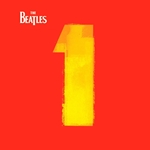
More Beatles? That’s the question a skeptic might reasonably ask at the recent announcement of a new version of the group's 2000 “1” hits compilation that became the biggest-selling album of the decade, the new edition being packaged with performance footage and films for each of the Fab Four’s 27 No. 1 hits on the album.
In fact, one of the prime movers behind the new “The Beatles 1/1+” project, which will be released Nov. 6, initially had the same reaction.
“My first question about it was whether this might be just a ‘ka-ching!’ prospect,” Jonathan Clyde, Apple Corps Ltd.’s director of production and producer of the “1/1+” told The Times on Thursday. He conducted a playback session in West Hollywood of several of the videos for about 50 music writers and a few VIPs including Doors drummer John Densmore and filmmaker Michael Lindsay-Hogg, who directed the Beatles' cinematic swan song, “Let It Be.”
“But the more we dug into the archives, the more I realized how much great material hasn’t been made available before,” he said. “And more than just visuals to accompany the songs, a story begins t details

Close but no Beatles reunion.
Yes, both remaining Fab Four members – Ringo Starr and Paul McCartney – are touring North America this fall and in one case – Toronto – arrive in town mere days apart. (Macca’s at the Air Canada Centre Oct. 17 and Ringo and his All-Starr Band are at Massey Hall Oct. 20)
But don’t expect them to appear on each other’s stages, says the 75-year-old Starr, whose trek includes seven Canadian cities in October promoting his 2015 album, Postcards from Paradise, which includes him recording with his All-Starr bandmates (the same lineup that has been touring with him since 2012) on a disc for the first time.
“I wouldn’t think so,” said Ringo with a chuckle.
“I was with (Paul recently) in England actually and he’s going on tour and I said, ‘Well, where are you going? I’m doing this,’” recalled the drummer, down the line from his L.A. home recently.
“And he’s like ahead of me. He put his tour together unbeknownst to me. I put mine together for the autumn unbeknownst to him and here we are. I mean, that’s CLOSE to being psychic.”
By: Jane Steven details

Go beyond "Imagine."
Like many artistic geniuses who died young, John Lennon’s catalog has been painstakingly examined since his death. But some of his best moments remain unappreciated when compared to the classics he penned both with the Beatles and as a solo artist. In honor of what would’ve been Lennon’s 75th birthday, we’ve rounded up some of his deeper cuts to slot between “Strawberry Fields Forever” and “Imagine.”
The Dirty Mac, “Yer Blues” (1968)
With the Beatles disintegrating around him in December 1968, Lennon appeared on The Rolling Stones Rock and Roll Circus, a goofy event staged by the Rolling Stones that also featured the Who, Marianne Faithfull, Jethro Tull, and Taj Mahal. While Lennon appeared alongside Yoko Ono for a strange performance and Mick Jagger for a bizarre comedy sketch, his standout — and, perhaps, the entire event’s standout — was a one-off supergroup formed with Keith Richards, Eric Clapton, and Jimi Hendrix Experience drummer Mitch Mitchell. Dubbed The Dirty Mac, the ensemble performed Lennon’s Beatles tune “Yer Blues” with a raucous gusto that makes the original version sound details

It became the track that many listeners skipped on Sgt. Pepper’s Lonely Hearts Club Band. Indeed, the Beatles’ “Within You Without You” challenged fans with its Indian instrumentation, at that point quite foreign to Western ears. Yet the track has transformed into one of the album’s more intriguing songs, its philosophical lyrics and intricate lead vocal showcasing George Harrison’s astonishingly rapid development as an accomplished singer and songwriter.
Composed on a harmonium after a dinner party hosted by Klaus Voormann, “Within You Without You” represents Harrison’s second full venture into Indian music, the first being “Love You To” from Revolver. In his autobiography I Me Mine, Harrison explained that the tune came first, then the line “we were talking…”
Recording took place on March 15, 1967, with no other Beatles present other than George Harrison. Under the direction of George Martin and engineer Geoff Emerick, Harrison and Indian musicians playing such instruments as the sitar, dilruba, tambura, tabla and svarmandal recorded the basic backing track. According to Mark Lewisohn’s The Complete Beatles Recording Ses details

JOHN LENNON fans celebrate his 75th birthday today – a new limited edition print has inspired an interactive art installation where fans can climb on the famous bed and recreate that famous picture with Yoko Ono.
London-based artist Russell Marshall has joined forces with gallery Beautiful Crime to produce a limited edition screen print in honour of John Lennon’s 75th birthday. The new release has been personally endorsed by Yoko Ono Lennon as the world celebrate the life and work of her deeply-missed husband.
The stunning limited edition screen print will launch at a special ‘bed-in’ on Lennon’s birthday (October 9) and will remain on display as part of a week-long event celebrating the much-loved British star. Beatles fans and Lennon lovers will be able to view the art and join in the creative process as they remember the iconic singer-songwriter. Visitors will be encouraged to take part by climbing into the installation and taking pictures and selfies in the bed.
The print itself is based on a classic image of Lennon taken on a New York roof in 1974 by his friend and legendary rock n roll photographer Bob Gruen. Hand screen-printed in retro blue on pearl at Jealous Studio details

While Ohio might seem like a less noteworthy tour stop for a rock star like Paul McCartney, the state’s prominent role in the history of rock ‘n’ roll contributes to its appeal.
On Aug. 24 University President Michael Drake announced at convocation that McCartney would be returning to Columbus for the first time in ten years.
The Oct. 13 concert at Nationwide Arena is one of just five upcoming dates on the former The Beatles member’s Out There tour.
When rock music first gained popularity, Ohio was at the forefront of that movement, said Todd Mesek, The Rock and Roll Hall of Fame’s vice president of marketing and communications. The term rock ‘n’ roll actually originated from Cleveland disc jockey Alan Freed, Mesek said.
“Ohio has always been a state where significant music history has been made — including the first rock concert, the Moondog Coronation Ball,” he said. “Even way beyond that, Columbus, Cleveland and Cincinnati have all been cities where the radio stations, the music clubs and the fans really broke some significant acts.”
Mesek said that Cleveland figures such as Freed and Leo Mintz, founder of the infl details
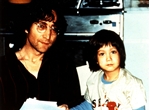
As we mark what would have been John Lennon’s 75th birthday, there’s another big day in the family too - son Sean turns 40 on October 9.
Sean was born in New York on his father’s 35th birthday.
After Sean’s birth, John took time off to care for his young son, spending time with himand inspiring his love of music. His debut into the music world came at age five, when he recited a story on his mother’s 1981 album, Season of Glass.
From childhood into his teen years, Sean continued to collaborate with his mother, contributing vocals and receiving production credit on her solo albums It’s Alright, Starpeace and Onobox.
At 16 he co-wrote the song All I Ever Wanted with Lenny Kravitz for his 1991 album Mama Said. By 1995 he had formed the band IMA (with Sam Koppelman and Timo Ellis) to play alongside his mother on her album Rising.
His current band is The Ghost Of A Sabre Tooth Tiger, with whom he’s played recent gigs at The Kazimier and Liverpool Sound City.
The band was formed in 2008 by Sean and Charlotte, after they met at the Coachella Music Festival.
By: Jade Wright
Source: Liverpool Echo
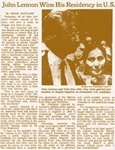
John Lennon would have turned 75 on Friday.
He was two months past his 40th birthday when he was murdered as he entered his apartment building, the Dakota, on the Upper West Side of Manhattan, on Dec. 8, 1980.
Absent from the music business for five years — most of it spent living the quiet life of a house husband and father in New York — he had just returned to recording. The “Double Fantasy” album he made with his wife, Yoko Ono, had been in stores less than a month. A single from the album, “Just Like Starting Over,” pretty much said it all.
This “starting over” was chronicled in a profile by Robert Palmer in The Times on Nov. 9, a month before the murder. The article, based on a series of interviews with the couple during the making of “Double Fantasy” and after its completion, featured a reflective Lennon and began like this:
“ ‘Is it possible to have a life centered around a family and a child and still be an artist?’ asked John Lennon.”
He answered his own question as Mr. Palmer interviewed the couple in their apartment. “In a way,” he said, “we’re involved in a kind of exper details

I never met John Lennon. I came to the party a little too late. I was only just out of college and working for Chrysalis Records in London when the news broke that John had been killed. The ground floor of our West End building housed the production offices of AIR Studios, Beatles producer George Martin’s recording business. The entire staff gathered in shock to mark the moment. I will never forget the look on George’s face.
George had weathered with dignity, throughout the 1970s, endless public vitriol from his former charge. Lennon belittled George’s ‘influence’ and input, and denied him credit, while McCartney, Harrison and Starr, George revealed, ‘were always sweet.’ Implacably loyal, George was of course distressed by the news of John’s murder. There would not even be a funeral at which to pay his final respects. In the end, he fled to Montserrat, where he had opened his dream residential studio the previous year. He sat for hours, staring at the ocean, he later told me, while listening to Lennon in his head. The recording complex, indeed the whole island, would be flattened by Hurricane Hugo within the decade.
Only after John’s death did I begin to cros details
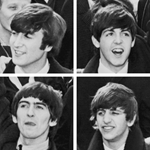
From 2013
Luckily, The Beatles were always about stretching the boundaries of the genre until those boundaries ceased to exist. Their special brand of musical adventurism is the reason we have glorious songs like “She’s Leaving Home,” which blows up those preconceived notions of what rock and roll is supposed to be.
“She’s Leaving Home” is a gorgeously sad ballad found on the sublime Sgt. Pepper’s Lonely Hearts Club Band, an album where The Beatles took seemingly mundane stories of everyday life and exploded them into something grand and transcendent via the stunning innovation and indomitable spirit of the accompanying music.
In the case of “She’s Leaving Home,” Paul McCartney created an affecting melody that was fit for the harps and strings beautifully arranged by Mike Leander. (George Martin wasn’t available to do it, but he did fill his usual role as producer.) For the lyrics, he looked to the local paper; the song’s story of a runaway teenage girl came from an article in London’s Daily Mail.
“We’d seen that story and it was my inspiration,” McCartney said in the book 1,000 UK #1 Hits. “Ther details
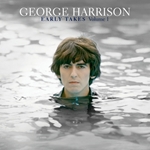
From 2012
"Everyone has choice/When to and not to raise their voices.” So sings George Harrison on “Run Of The Mill,” one of the ten outtakes and demos collected on Early Takes, Volume 1, a companion piece to the DVD/Blu-Ray release of Martin Scorsese’s documentary about George’s life, Living In The Material World.
It’s a telling line, because Harrison’s voice, not his slide guitar or sitar or ukulele, is what’s most prominent on these tracks, most of which date to the period around the release of All Things Must Pass. That voice had been muffled somewhat by the songwriting genius of his fellow Beatles, John Lennon and Paul McCartney, relegating the so-called Quiet Beatle to one or two tracks per Fab 4 album. Once he got the chance to go solo, it all came gushing forth, and the result was arguably the best Beatle solo album.
What makes this release more worthwhile than your average collection of odds and sods is the fact that it puts the spotlight on Harrison’s own songwriting acumen. While you can’t argue with the results producer Phil Spector got on All Things Must Pass, it’s nice to hear album tracks like “Run Of The Mill,” details
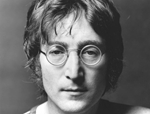
John Lennon would have been 75 on October 9th. His music had a profound impact on the world, and yet the years have not been kind to his legacy. Something Happens front-man and presenter Tom Dunne pays tribute to the former Beatle and explains why he still loves him.
I loved John Lennon. It makes no sense, we never met, he was a poster on my sister’s bedroom wall -not even mine - but when my mother told me of his death on December 8th 1980 she could not have delivered worse news. I skipped lectures, listened to Beatles records with a friend all day, and the next day recorded a mark so low in an Engineering exam I was brought before the Dean!
Prior to his death the question “Lennon or McCartney?” divided fans in the way “Blur or Oasis?” would years later. But after his death it would take a good two decades before anyone had the temerity to argue Paul’s case again. John was the caustic wit, the true rebel, the grit that made the pearl, the steel, the intelligence and, dare we say it, the greater talent.
Evidence of his standing in the band was revealed to me years later in an interview with Sir George Martin, in Dublin to perform at the NCH. I asked the usual questions, details
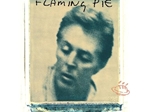
Earlier this month, Paul McCartney reissued two of his 1980s albums as he continues to release solo (and Wings) material that has been hard to find or has been out of print. “Tug of War” is a fantastic record, and “Pipes of Peace” is ... well, it has some good songs.
Let me throw you a curve. Rather than discuss those albums, I’d rather focus on one of my favorite McCartney releases. In fact, I’d like to talk about the first McCartney record that I bought when it was a new release: “Flaming Pie.”
Before the May 1997 release of “Flaming Pie,” I’d already owned McCartney’s first solo album, I had “Band on the Run” and a number of other records. All of them had been released well before I’d ever become a fan. “Flaming Pie” was new — on the shelves, a chart contender (it earned a gold record and was No. 2 on the Billboard 200 charts) — when I bought it.
I picked up “Flaming Pie” that May because I knew I was going to be working as a counselor at a Boy Scouts summer camp for the second straight summer, and I wanted a new album to spend some time with.
As a 16 year old, my music details

At a time when any pop star with two Top 40 hits is hailed as a legend, Ringo Starr is the genuine article.
Born 75 years ago in the Dingle section of Liverpool, Starr, along with Paul McCartney and the late John Lennon and George Harrison, forever redefined and altered the course of popular music.
Starr's drumming anchored The Beatles at rowdy Hamburg dives and over the screaming din at Shea Stadium. He has fended off crazed fans and battled an army of Blue Meanies.
Some would rest on their laurels, but not Richard Starkey, MBE. Indeed, it has been a particularly busy year for the once and still fab drummer.
Starr released a new album, "Postcards From Paradise"; was inducted into the Rock and Roll Hall of Fame by McCartney; published "Photograph," a collection of images from his private collection; announced plans to auction off 800 personal effects to benefit the Lotus Foundation charity he established with wife Barbara Bach; and kicked off a North American tour with his All Starr Band.
He is in the midst of a North American tour this month. Starr fielded a few questions before the start of the tour.
You launched the All Starr Band in 1989 with a talented lineup that changed wit details

John Lennon would have celebrated his 75th birthday this Friday. To celebrate the milestone, Yoko Ono, his widow, attempted to organize a party and a gift for him in New York City's Central Park. She invited the world to come and break a world record in Lennon's honor: arranging the world's largest human peace sign, a sign that essentially epitomizes Lennon's activism.
Fans came from all over — Italy, Venezuela, Ohio — to answer the call. Activists brought signs protesting war in all its forms. An unexpected number of children field tripping from several New York City schools sat singing along to tunes from the Beatles catalog piped through the loud speakers.
"We are more connected globally now," Luz Cano, a 14-year New York resident from Argentina, told Mic, marveling at the diversity. "I think younger generations are more aware of trying to make the world a better place and create peace."
The age range between the youngest and oldest participants was vast. However, it revealed the event's deeper significance: Beyond creating a visual tribute for Lennon, it was an opportunity to pass along the late artist's message to the next generation.
"If we instill in our children an understandi details
